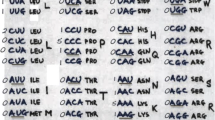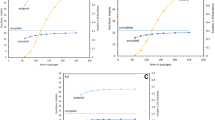Abstract.
Annotated, complete DNA sequences are available for 213 mitochondrial genomes from 132 species. These provide an extensive sample of evolutionary adjustment of codon usage and meaning spanning the history of this organelle. Because most known coding changes are mitochondrial, such data bear on the general mechanism of codon reassignment. Coding changes have been attributed variously to loss of codons due to changes in directional mutation affecting the genome GC content (Osawa and Jukes 1988), to pressure to reduce the number of mitochondrial tRNAs to minimize the genome size (Anderson and Kurland 1991), and to the existence of transitional coding mechanisms in which translation is ambiguous (Schultz and Yarus 1994a). We find that a succession of such steps explains existing reassignments well. In particular, (1) Genomic variation in the prevalence of a codon's third-position nucleotide predicts relative mitochondrial codon usage well, though GC content does not. This is because A and T, and G and C, are uncorrelated in mitochondrial genomes. (2) Codons predicted to reach zero usage (disappear) do so more often than expected by chance, and codons that do disappear are disproportionately likely to be reassigned. However, codons predicted to disappear are not significantly more likely to be reassigned. Therefore, low codon frequencies can be related to codon reassignment, but appear to be neither necessary nor sufficient for reassignment. (3) Changes in the genetic code are not more likely to accompany smaller numbers of tRNA genes and are not more frequent in smaller genomes. Thus, mitochondrial codons are not reassigned during demonstrable selection for decreased genome size. Instead, the data suggest that both codon disappearance and codon reassignment depend on at least one other event. This mitochondrial event (leading to reassignment) occurs more frequently when a codon has disappeared, and produces only a small subset of possible reassignments. We suggest that coding ambiguity, the extension of a tRNA's decoding capacity beyond its original set of codons, is the second event. Ambiguity can act alone but often acts in concert with codon disappearance, which promotes codon reassignment.
Similar content being viewed by others
Author information
Authors and Affiliations
Additional information
Received: 26 October 2000 / Accepted: 19 January 2001
Rights and permissions
About this article
Cite this article
Knight, R., Landweber, L. & Yarus, M. How Mitochondria Redefine the Code. J Mol Evol 53, 299–313 (2001). https://doi.org/10.1007/s002390010220
Issue Date:
DOI: https://doi.org/10.1007/s002390010220




